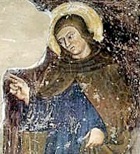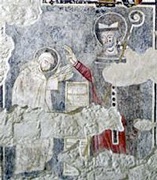


Detail of a fresco in San Bevignate
All that is known about “St” Bevignate comes from the poorly documented traditions that surround Raniero Fasani.
Raniero Fasani
According to an anonymous “Lezenda de fra Rainero Faxano”, he was hermit at Perugia, during the time of the Bolognese podestà, Orlandino Marescotti (which the legend dates to 1258 but which was actually in 1263). While he prayed before an image of the Virgin, he saw her crying, presumably because of the sinfulness of mankind, and resolved to devote himself to preaching penance and promoting the practice of self-flagellation. An unknown companion appeared, who identified himself as brother Bevignate. Together, they went to San Fiorenzo, managing to enter it despite the fact that it was closed. The sacristan who found them inside the locked church was moved to submit to a life of penance.
The next night, a young lady escorted by two boys appeared to Raniero and gave him a letter. Bevignate explained that this lady was the Virgin and the boys were SS Michael and Gabriel. The letter revealed that God was inflamed by the sins of men and intent upon their destruction, but that the Virgin had interceded and persuaded Him to allow time for penitence. Encouraged by Bevignate, Raniero returned repeatedly to see Bishop Bernardo Corio of Perugia until the latter agreed to read and act upon the contents of the letter. Thus was born the flagellant movement, which rapidly spread across north and central Italy.
The statutes of 1824 of three associated confraternities:
-
✴the Confraternita di Sant’ Agostino (formed in 1317);
-
✴the Confraternita di San Domenico (first documented in 1318); and
-
✴the Confraternita di San Francesco (first documented in 1320)
claims that they had been among the numerous lay confraternities known as Disciplinati di Gesù Cristo that had been inspired by Raniero Fasani.
“St” Bevignate
Apart from this legend, nothing is known about Bevignate. Nevertheless, the Templars, who took over the Oratorio di San Gerolamo near the hermitage of Raniero Fasani, consecrated the church they built there as San Bevignate. The Templars became associated with the attempts by the Commune to secure the canonisation of Bevignate (see below).


Two frescoes (1260s) in the apse of the church bear witness to some aspects of the cult:
-
✴the Bishop of Perugia grants him permission to live as a hermit (damaged by the opening of a door); and
-
✴the Bishop gives him a hermit’s cowl, thereby taking him into episcopal protection..
Other frescoes in the apse feature processions of flagellants.
Campaign for Canonisation
In 1260, the Commune (at the instigation of the bishop) sent four ambassadors to Pope Alexander IV to press for the initiation of an enquiry into the case for canonisation. The powerful Templar, Bonvicino d’ Assisi, who was the Chamberlain at the papal court and who had established the Templar complex at San Bevignate, gave his active support, but to no avail. Similar approaches in 1266-7 to Pope Clement IV (who had been elected and crowned at Perugia) also failed.
Undaunted, the Perugians persisted. Hopes were particularly high in 1277, when the Templar Grand Master, William of Beaujeu was at the court of Pope John XXI at Viterbo. Two Perugian ambassadors were duly dispatched, but John XXI died and William of Beaujeu returned to the Holy Land. In 1285, the Commune ordered a search of San Bevignate in order to secure the relics of Bevignate, doubtless because there was still hope of his canonisation.
A series of statutes in the 14th and 15th centuries imposed on the civic authorities an obligation to continue to press the case for canonisation. In 1453, perhaps having despaired of official recognition, the Commune decreed that the feast of “St” Bevignate should be celebrated in Perugia each year on 14th May, in effect carrying out a lay canonisation.
In 1605, Bishop Napoleone Comitoli achieved papal permission for a local cult. In 1609, he arranged for the simultaneous translation of the relics of three saints:
-
✴those of St Herculanus from the Duomo to Sant’ Ercolano;
-
✴those of St Peter Abbot from the sacristy to the high altar of San Pietro; and
-
✴those of “St” Bevignate from San Bevignate to the Duomo.
They relics of “St” Bevignate are still in the Duomo, under the altar in the Cappella di Santo Stefano (right transept).
Return to Saints of Perugia.

